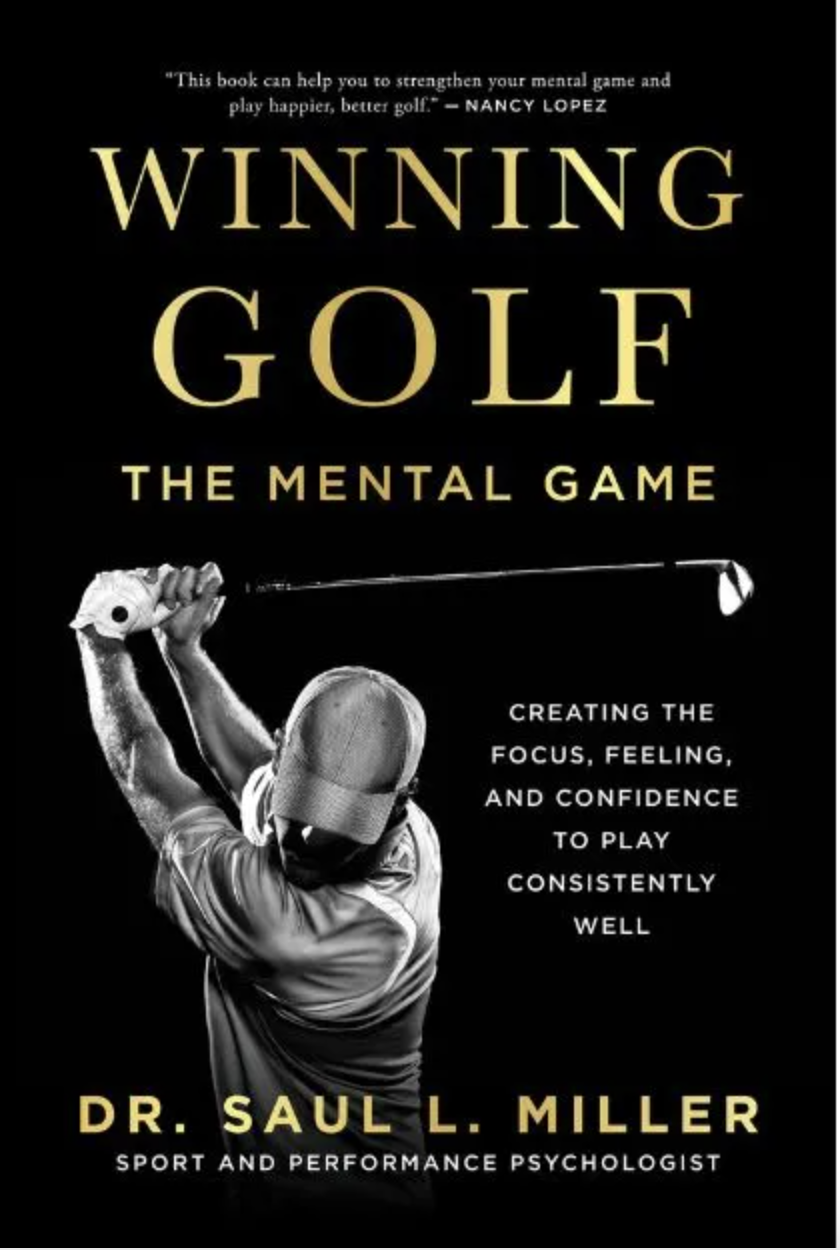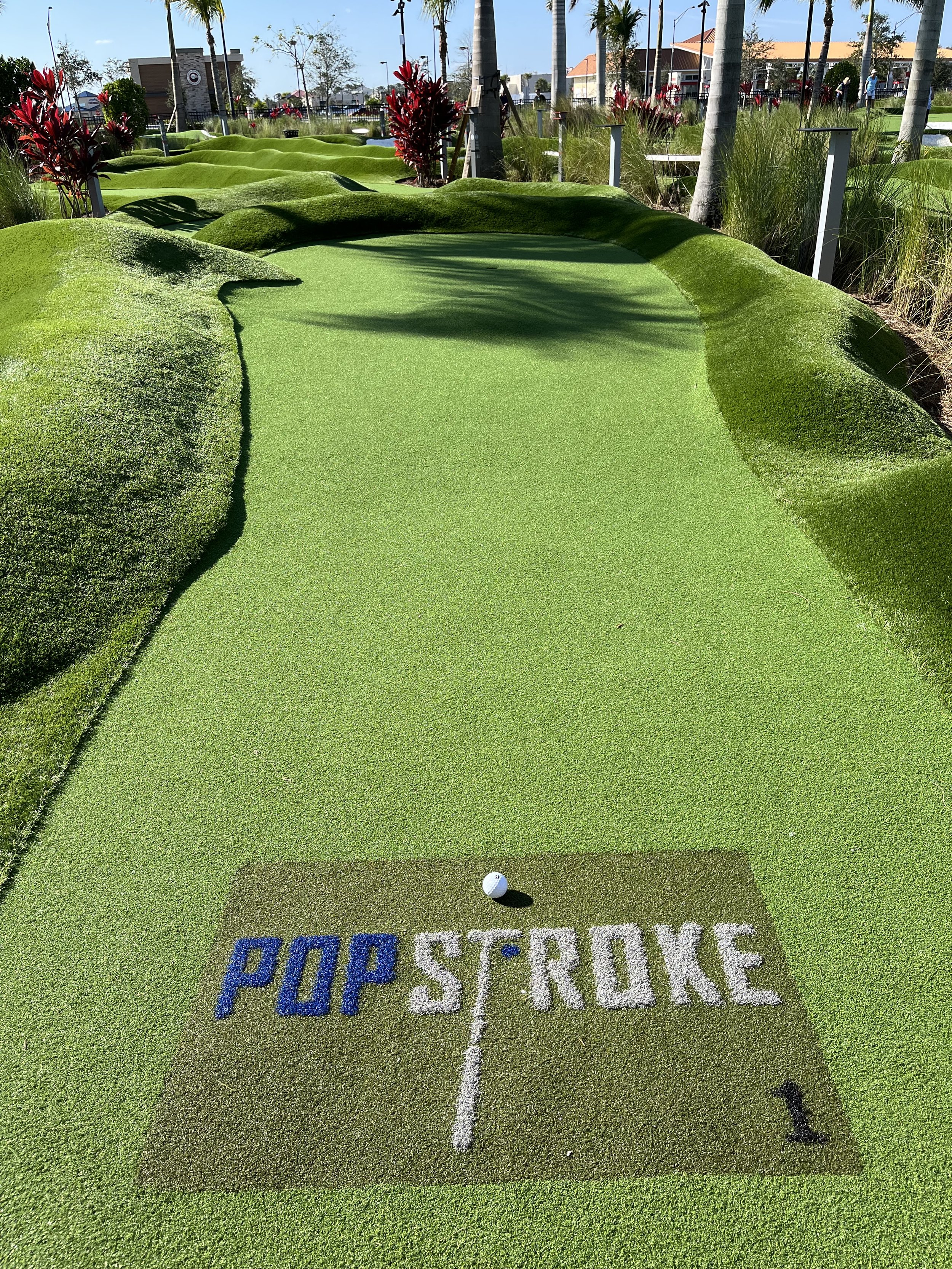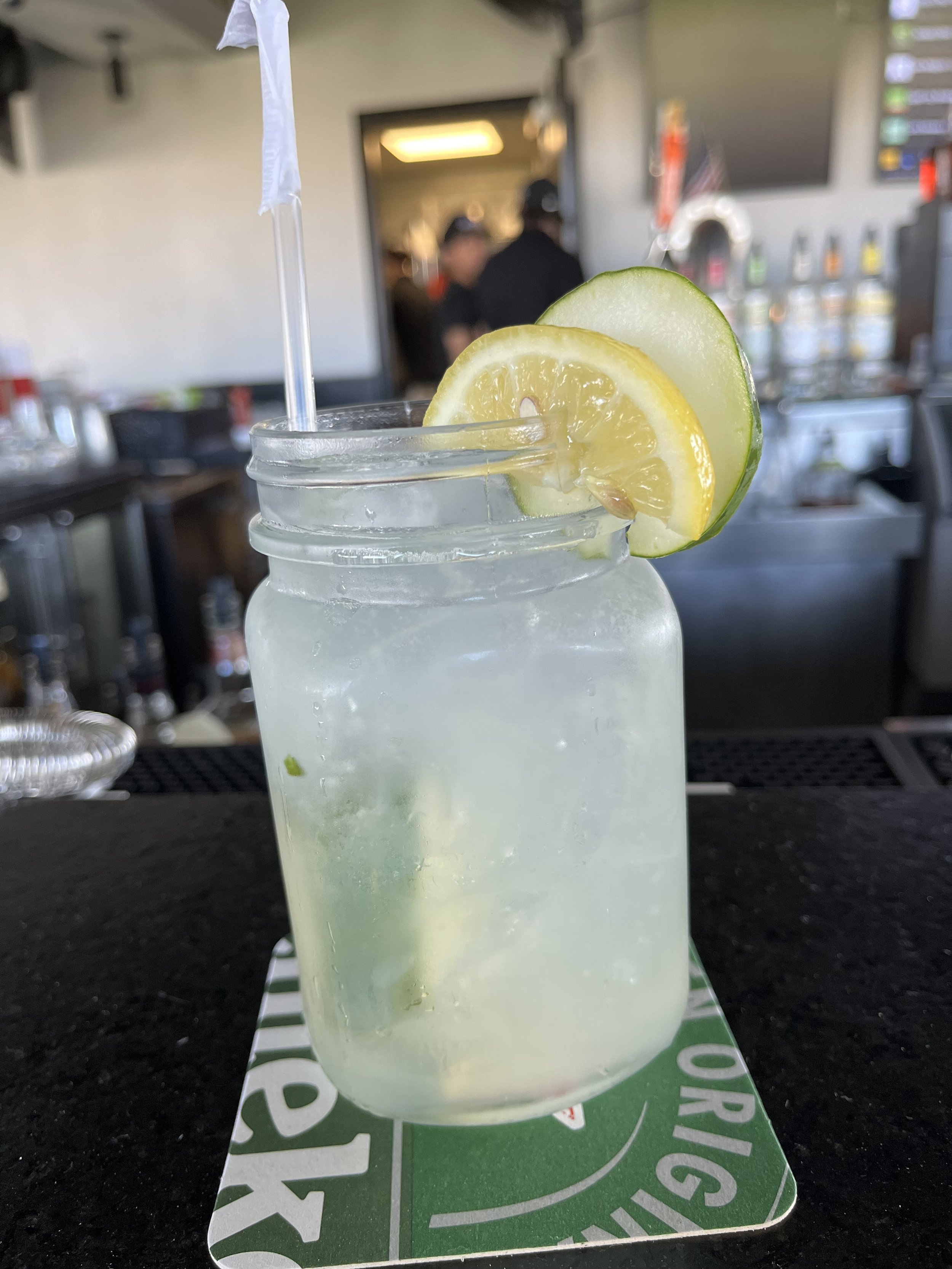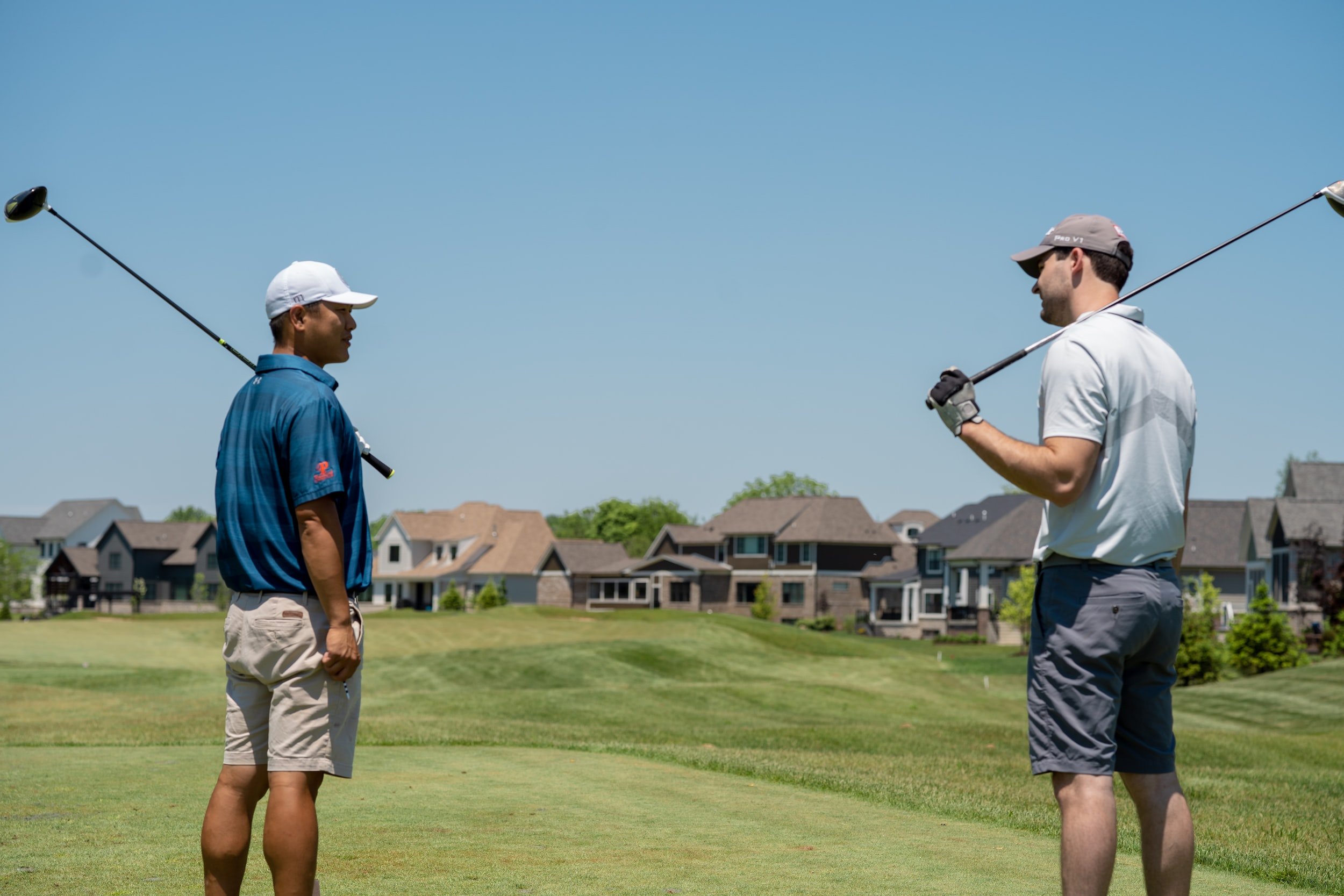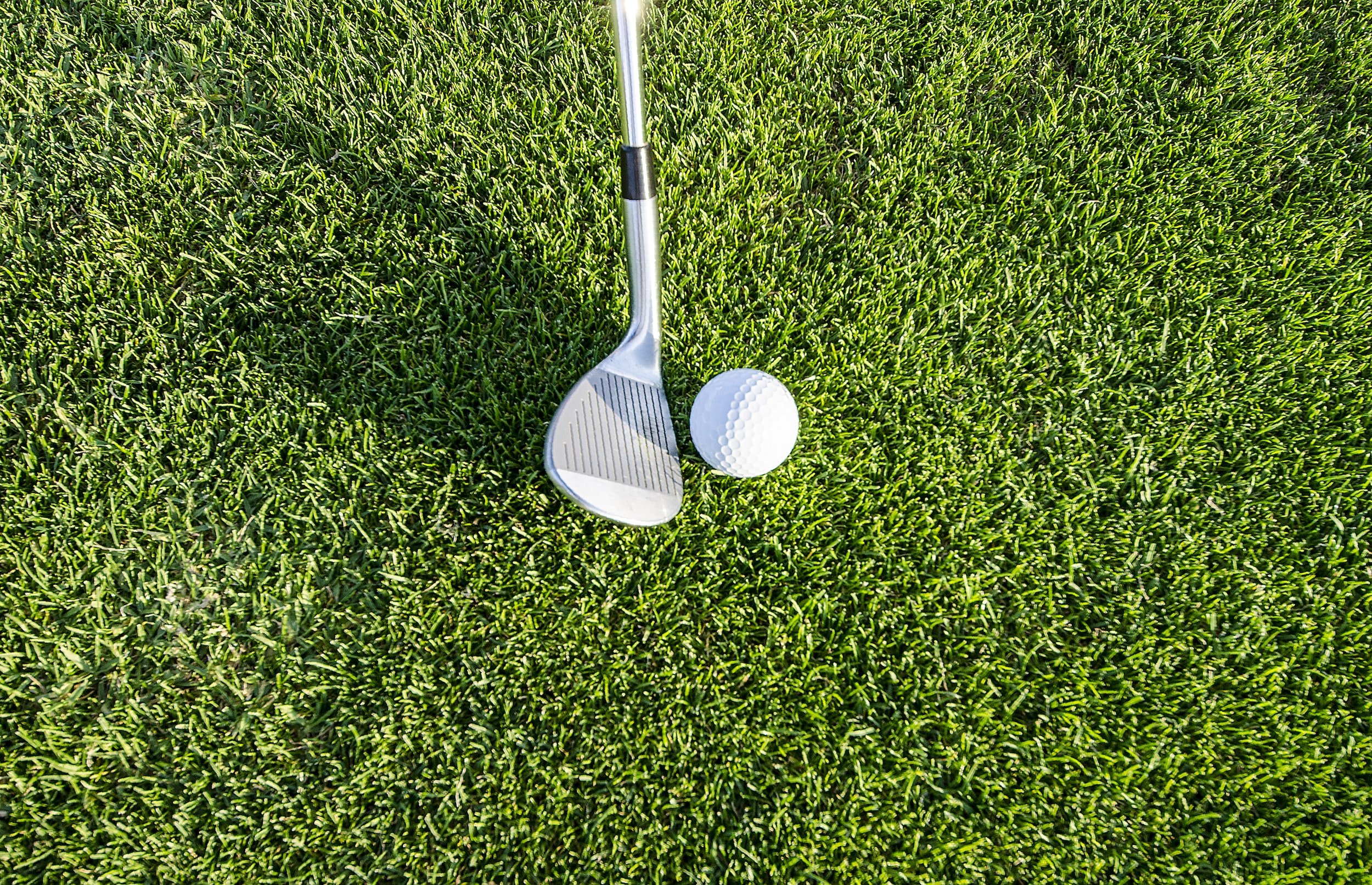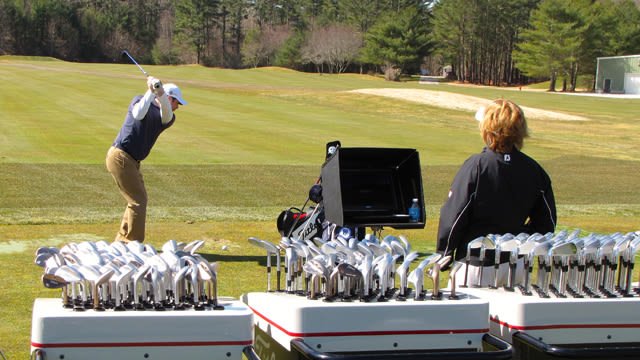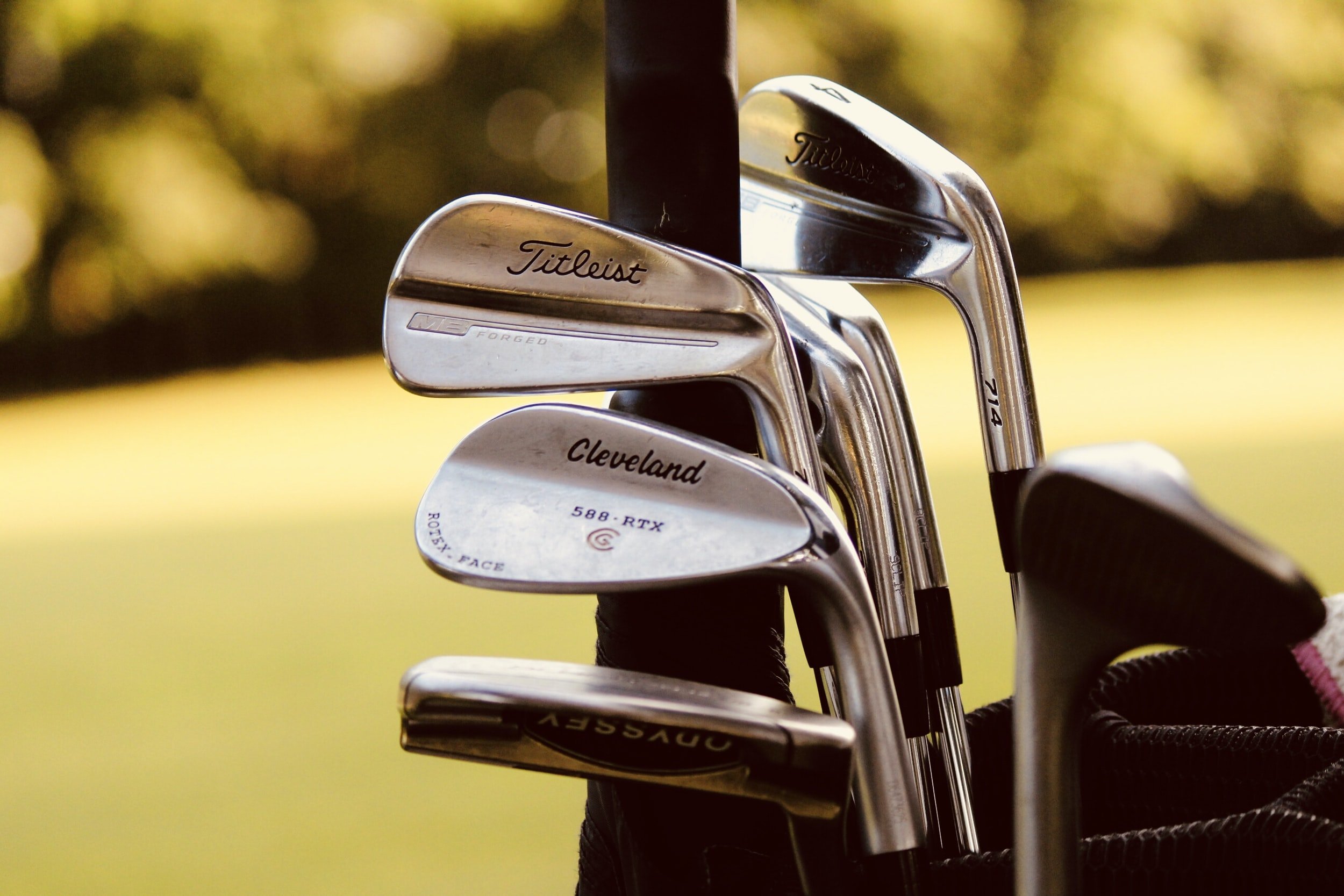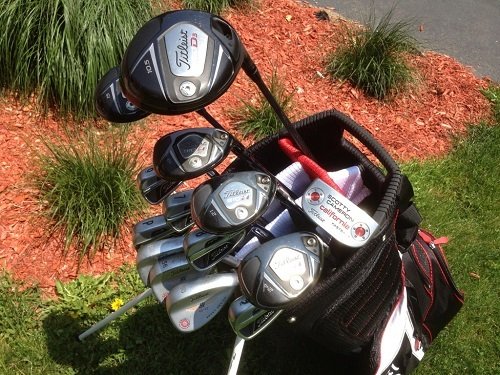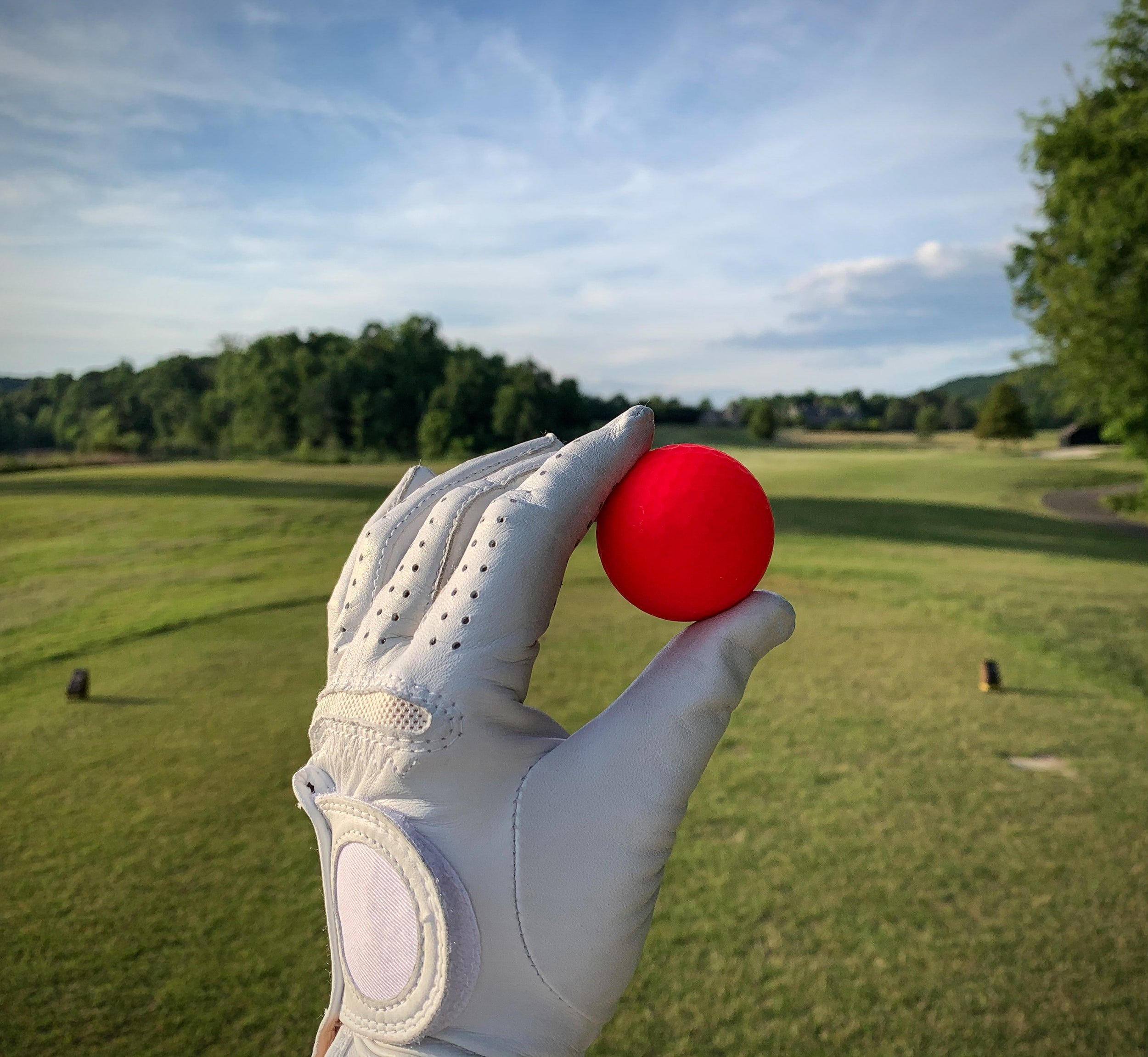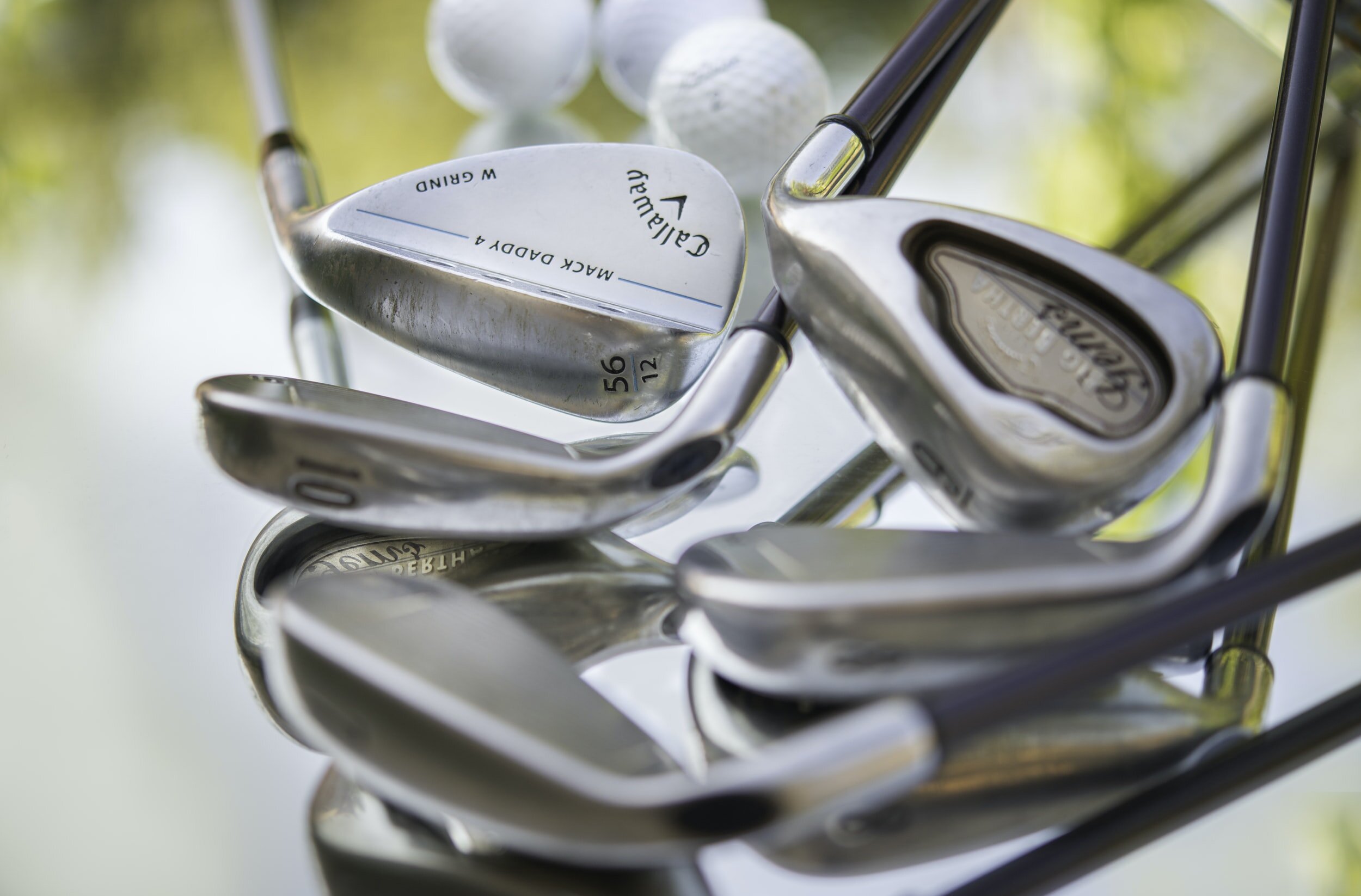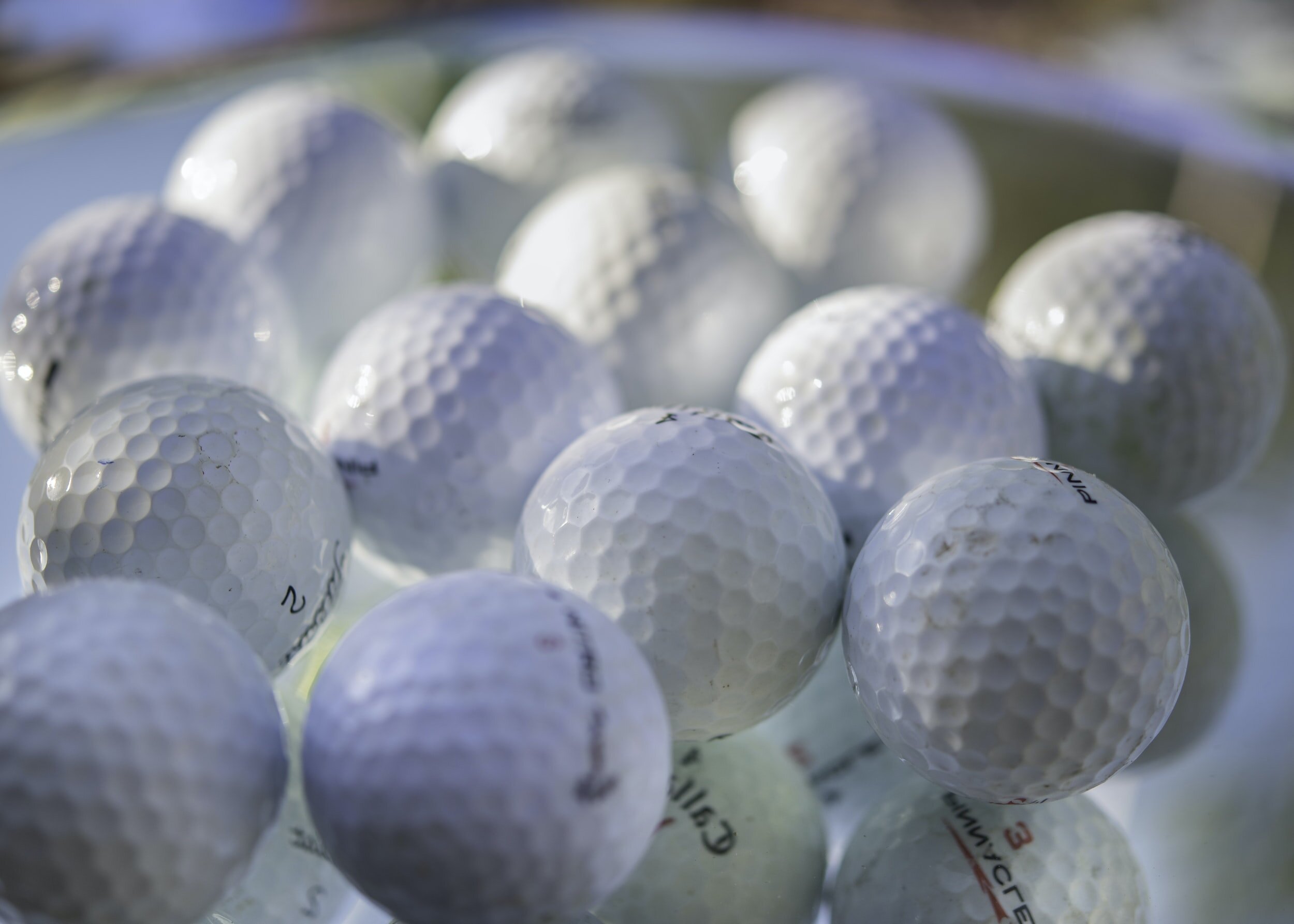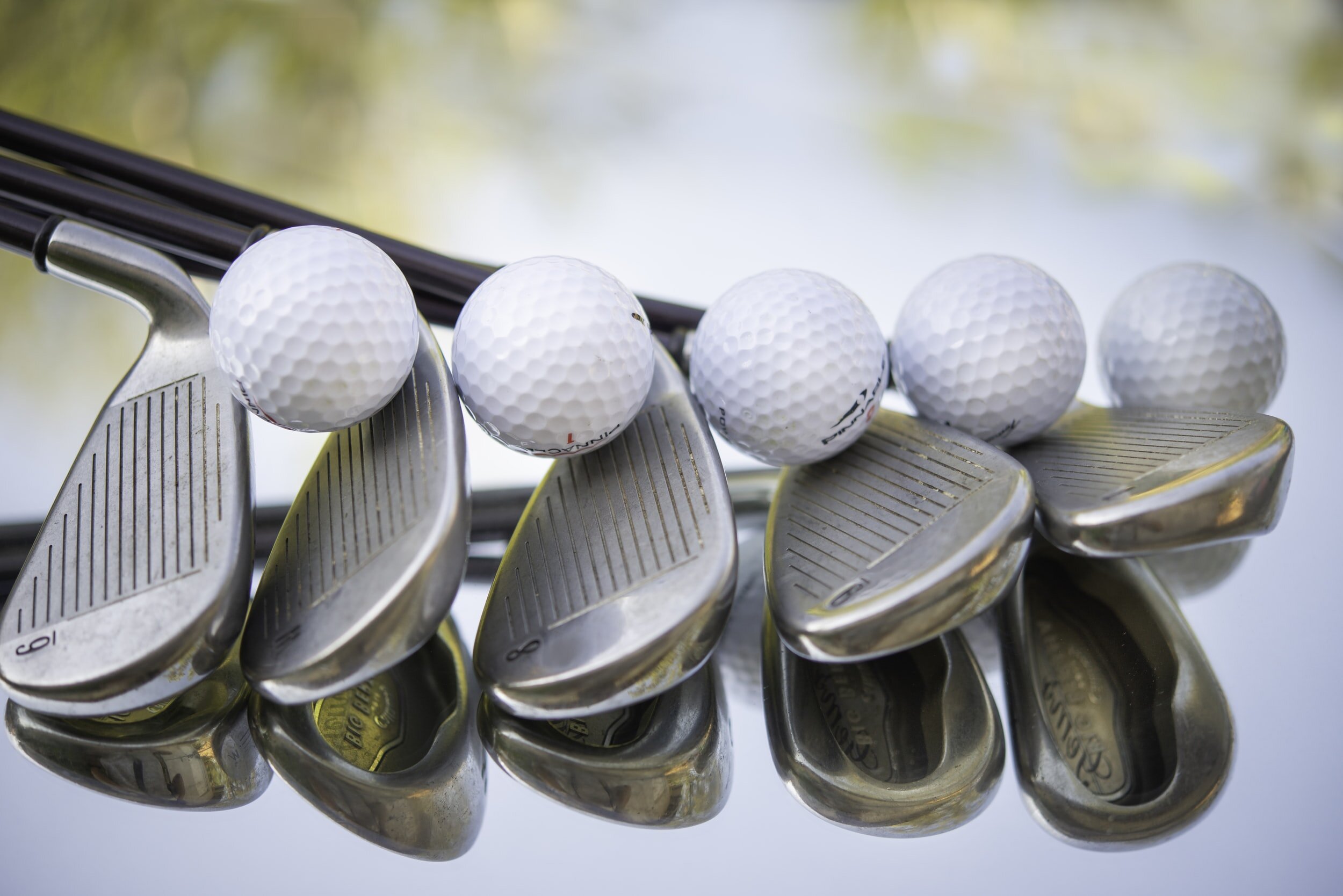BOOK REVIEW: Winning Golf - The Mental Game
In Winning Golf: The Mental Game, author Dr. Saul L. Miller offers golfers tips and techniques to quiet their mind en route to playing the best golf of their lives. Read our review here.
We’ve all heard it before: the mental side of golf is as important as having a technically sound golf swing. Rounds can be saved or ruined depending on a player’s mindset. In Winning Golf: The Mental Game, sports psychologist and author Dr. Saul L. Miller offers insight on exactly how a player’s mental state impacts their game, as well as techniques to help any golfer play better.
Dr. Miller has had a long list of high profile clients over the years, including those from the NBA, NHL, NFL, professional golf and even Fortune 500 companies. In Winning Golf, he brings decades of expertise and research into an easy-to-read, brief guide from which any golfer can learn how to manage stress, fear, and anxiety on the course.
Featuring interviews from dozens of professional golfers across multiple tours, including hall of fame players from yesteryear, Miller outlines the causes of stress on the course while under pressure. It’s amazing to be reminded of how the human body responds to stress (fight or flight), which includes much more than muscle tension and cloudy judgement.
What we appreciated most about Winning Golf were the simple breathing exercises and other stress-reducing techniques described in the text. This book reads more like a self-help guide than a commentary on the human mind, walking readers through exercises they can practice long after finishing the book.
As with any self-help or golf improvement book, the “homework” for the reader is relatively simple yet detailed enough where we found it helpful to take notes as a reminder when on the golf course. There’s no doubt that Miller’s decades of expertise is highly valuable; however, remembering to practice mindfulness and stress-reducing exercises while playing golf might be a difficult ask for some.
To that end, while Winning Golf can be beneficial to any golfer of any level, it is perhaps most helpful for competitive golfers looking to enhance their skills and mindset during tournaments. Most weekend players, while not immune to frustration and pressure, will likely focus more on playing with their friends or grabbing a hotdog at the turn.
At roughly 200 pages in length, Miller’s Winning Golf packs a ton of helpful information into a compact offering to which golfers can refer multiple times during a season. Get ready to grab a highlighter or notebook to remember key tips and techniques for future reference.
To learn more about Dr. Saul Miller, including his long menu of best-selling books, visit the author’s website here.
Golf Shaft Deep Dive Series
Understanding golf shaft options and tech can be difficult. In this deep dive series we offer a few high level concepts to keep in mind for your game.
Understanding golf shaft technology and how they benefit your game can be difficult. The sheer volume of shaft options on the market can be staggering, especially since there is no industry standard for flex type. How can you possibly know which golf shaft is right for your game?
We put together a deep dive series on the Golf Unfiltered TikTok account recently to help answer some of the most common questions about golf shafts. You can view this five-part series below.
Still have questions? Feel free to reach out via the Contact page or by leaving a comment below.
Part 1: Golf Shaft Bend Profiles
The first video in our series introduces the concept of golf shaft bend profiles: different types of bend at the tip, middle, and butt of the shaft. These can differ widely from one shaft type to the next for very specific reasons.
Part 2: Understanding golf shaft markings
What are all those number and letter combinations on your golf shaft? In this video, we try to explain a few of the more common markings you’ll see when purchasing a new golf shaft or golf club.
Part 3: Understanding Golf Shaft Frequency
Since no two golf shaft flexes are the same across the board, we have to think about another measurement when choosing a golf shaft: shaft frequency. Learn more about this concept in our third video.
Part 4: Steel golf shafts vs graphite golf shafts
Golf shaft technology has come a long way over the years, providing golfers more options than ever before. Why would you choose graphite over steel shafts, and what are the potential benefits of doing so?
Part 5: Golf Shaft Checklist
What are the top three things you should look for when purchasing a new golf shaft? In this video we offer a few recommendations to consider.
PopStroke: The Next Generation of Putt Putt Golf?
PopStroke is a modern take on classic putt putt courses. Can the Tiger Woods-backed company catch on with a new generation of golfers? Dan Hauser explains here.
It’s no secret I’m a big fan of Tiger Woods. So a few years ago when it was announced he was opening his own chain of putt putt (or mini golf, whichever you choose) courses I was intrigued.
At the same time, I was skeptical. Even if Tiger was putting his name behind it, did we really NEED another putt putt course? After all, how many different ways can you reinvent hitting a brightly colored ball into a clown's mouth?
PopStroke was supposed to be different though. It was supposed to bring a unique twist to the concept of mini golf with more realistic putting surfaces and the types of breaks and undulations you would see on a real golf course.
Let’s see if it succeeds in its mission.
Dan Hauser at PopStroke Port Saint Lucie location.
PopStroke - Port Saint Lucie
PopStroke opened its first location in Port Saint Lucie in 2019. Being the closest location to me I wanted to check it out but it didn’t end up happening (covid, adulting, just life in general, etc). So, this past weekend when my wife brought up finally getting out there and checking it out, you could imagine my excitement.
Well, let me tell you, it did not disappoint.
The Port St Lucie location features two courses, the Red Course and the Black Course (clever, huh?). For $20 you get a day pass which allows you access to the facility for the entire day (you can even leave and come back if you want) and you can play the two courses as many times as you want.
We went on Sunday afternoon which surprised many since it was Championship Sunday but let me tell you, PopStroke had me covered and then some. A massive big-screen TV graced the side of the building with the Eagles-49ers game on and you had a clear view of it from every hole on the property. Thanks to the app, we were also able to order drinks right to whatever hole we were on, meaning there was no break in the action both on the course and in the football game (even though the game was a blowout).
PopStroke Hole 5 - Port Saint Lucie
PopStroke is more than just mini golf though. The facility has an outdoor bar and restaurant that rivals many golf course establishments. From sandwiches to apps, to build your own pizzas there is something for everyone. They also have quite the drink menu with signature drinks that all play off the golf theme (I got the Country Club Cooler and it was quite refreshing).
PopStroke - Country Club Cooler drink.
If putt putt isn’t your thing, or you need a break for a little there is even a little lounge area with ping pong tables and cornhole boards. And, for the little ones a full playground complete with slides.
PopStroke and Tiger really did think of everything when they came up with the idea and it is truly different than any putt putt experience you have ever had.
Golf Ball Deep Dive Series
Thousands of golfers watched our golf ball deep dive series on TikTok. Now you can, too, all in one place. Click here to read more.
Have you ever wanted to know the difference between a 2-piece and a 3-piece golf ball? Ever wonder why there are so many different options to choose from? Why do manufacturers offer different golf ball dimple patterns?
You’re in luck.
We recently completed a golf ball deep dive series on the Golf Unfiltered TikTok page, where we cover all of these topics (and more). Below you’ll find all six of the videos, along with a brief summary of what’s captured in each.
Have more questions about golf balls that weren’t covered below? Is there a topic you’d like us to cover in the future? Be sure to send us a note via the Contact page.
Part 1: Understanding the Golf Ball Core
In the first video of this series, Adam discusses the importance of a golf ball’s core, along with its purpose and why you should care about it in the first place.
Part 2: What is a 2-Piece Golf Ball?
The second video in the series deconstructs the different golf ball layer types, specifically in defining a two-piece golf ball. Recommended golfer type for this golf ball option is also explained.
Part 3: What is a 3-Piece Golf Ball?
The third video in the series shifts to explaining 3-piece golf ball construction, along with the golfer handicap recommendations on who will benefit the most from playing one.
Part 4: What is a 4-piece golf ball?
Our fourth video dives deeper into golf ball construction, including the benefits of playing a 4-piece golf ball (and even a 5-piece ball!). Are you good enough of a golfer to play this ball type? Does it even matter? Watch to find out!
Part 5: Why do golf balls have dimples on the cover?
The fifth video in our series covers the different golf ball dimple pattern types, including the range of dimple volume and their purpose. What would happen if golf balls didn’t have dimples? Why are there so many on the cover?
Part 6: Understanding the golf ball cover
The sixth video in our series describes the function and benefits of different golf ball cover materials, including urethane and surlyn. What are the differences and how are they similar? Which cover type should you play? Watch more to find out!
Part 7: Golf ball price points
The final video in our series shifts to the different price points for golf balls. Do we really have to pay top-dollar to play good golf balls? Why do some cost so much while others don’t? We cover all of this, and more, in the video above.
Artificial Intelligence and Golf Already Strongly Connected
Interest in artificial intelligence is spiking in all walks of life, including in golf. Here are a few ways this technology is already being used in the game.
With the advent of powerful artificial intelligence (AI) technology like Deep Blue, AlphaGo, Open AI/ChatGPT and dozens of new services that surface every month, our everyday lives are sure to be impacted one way or another. In golf, however, AI has already been making its mark for years in multiple areas of the game.
Here are a few of the major areas in golf already benefitting from the use of this new technology.
Golf Equipment Design
Callaway Golf will widely be known as the leader in the clubhouse in terms of incorporating AI into golf club design. In 2019, Callaway introduced “Flash Face;” a driver club face completely designed by an AI-powered $8 million supercomputer that could generate 15,000 face iterations and hundreds of impact simulations. Since then, Callaway has incorporated AI into the design of future driver, woods, and iron iterations.
This tech drastically shortened lead times for designing a golf club that was arguably years ahead of its time. Competing brands like TaylorMade Golf, Titleist, Mizuno, Srixon and others have dabbled with the use of AI in the years that followed, leaving no doubt that they’ll incorporate the tech into future designs.
Golf Instruction
The use of AI has also been widely used in helping golfers of all levels improve through enhanced instructional techniques guided by AI and data. Companies like Sportsbox AI, for example, have partnered with the best instructors in the world to enable coaches and golfers to access comprehensive 3D motion data to study the golf swing like never before.
Layman golfers are able to bring similar technology to their smartphones through the use of AI-powered apps to record their golf swings and receive instant analysis while on the driving range. Brands like Arccos Golf incorporate the use of sensors installed into the grips of golf clubs that transmit signals to a user’s smartphone where an AI-powered app provides data once never thought possible.
Golf Simulation
Golf is no longer confined to the boundaries of an actual golf course thanks to entertainment centers like TopGolf and launch monitor simulation packages like Trackman Range.
Both incorporate ball launch monitor technology, radar, and AI to offer golfers a powerful “simulated golf experience” that provides real-time shot metrics on every swing. Golfers can even play computer-generated versions of the world’s most famous golf courses and receive data on every shot along the way. AI-incorporated features often serve as a player’s virtual “caddie” that learns a player’s tendencies over time and can make club selection recommendations in real-time.
Golf has only scratched the surface as to how AI can be used to enhance the game’s overall experience in every facet of the sport. As humans — and machines — learn new ways this technology can be used, there’s no ceiling to where golf can climb in this area.
How to Get More Involved in the Golf Community
Getting involved in the golf community is a great way to meet new people with common interests. Here are some ideas if you’re just getting started.
In addition to the obvious thrill of slicing a perfect drive right down the fairway and the constant pursuit of improvement, one of the most enjoyable aspects of following golf is the social aspect of the game. Unfortunately, while getting outdoors for a game might be the end-goal for most golf fans, finding the right crowd of people to play with can often be easier said than done.
So if you are tired of sitting at home, mulling over the latest golf odds in desperate anticipation of the next major tournament, follow the tips, tricks and strategies set out in this article to help you to get more involved in the golfing community. You never know, your new buddies might even have some insider info that will help to improve your betting game!
Check out your local golf leagues and clinics
One surefire way to put yourself on a path to meeting more golf buddies, is checking out what weekday leagues, beginner clinics and social meetups are available in your area. Although you are more likely to see these cropping up in the summer months — after all, who isn’t more social when the weather is fairer — you will often find that these run throughout the year.
Evening nine-hole leagues are particularly popular among the after-work crowd, although there will more than likely be a league to suit a wide range of individuals and skill levels. To find information on what golf leagues are available near you, a good place to start is with your local golf clubs or courses. You will often find information on these leagues posted on bulletin boards, or even on social media!
Leverage social media
Although golfers are not often thought to be the most tech-savvy crowd, you will be surprised at how important social media is to the modern golfer.
Regardless of whether you choose Instagram, Facebook or some other sport-specific platform, you will be surprised at how easy it is to connect with local golfers near you using these platforms. Platforms such as Twitter can also be useful if you are heading to a new area for the first time or trying out a new course, as it can allow you to get the insider tips in advance of tee-off!
No matter what stage of your life you are in, you should not be afraid to leverage the power of social media to get more involved in the golfing community!
Join a club
Ever since the game was first invented, golfing and country clubs have proved formative in developing the game. While these clubs have had an obvious impact on developing the game through courses and tournaments, they have also been equally important in building a golfing community.
While you might be hesitant to join a club if you are still a new golfer early on in your playing career, there is arguably no better time to do so. In fact, when you are still relatively young in playing years, this could be the time at which you get the most out of your membership in terms of guidance from more experienced players.
There will likely be several clubs to join in your local area, with some more playing oriented and others more social. Depending on what you want out of your membership, one may suit you more than the other!
Get your friends and family involved
Another tip to getting more involved in your golfing community, is to take a more active role in building it. With that said, if you want to grow your local golfing community feel free to invite friends and family members to play with you. This can be a great way of giving those close to you a taste of the game. Who knows, they might end up enjoying it!
Search for events
A good way to ingratiate yourself in the local golfing community is to take the opportunity to attend as many events as possible. Often, these events will pair you up with other players, which takes some of the effort of actively socializing out of the equation!
Attending these events is a great way of widening your social circle and getting more involved with local golf clubs. They also often have a charity element to them, which is an added bonus!
Why Does Wedge Bounce Matter?
Understanding wedge bounce can be helpful for your short game. There are many factors to consider, including how you swing your club and where you play most of your golf.
The bounce of your wedge is easily explained but not commonly understood. Apart from being the rounded angle created between the wedge’s leading edge and the lowest point of its sole, understanding how customizing bounce to your swing tendencies and playing conditions can be very important.
Let’s take a closer look.
What is Wedge Bounce?
The angle between the wedge’s leading edge and lowest point of its sole is referred to as a wedge’s bounce. When you see the term “bounce” you probably think of the more traditional use of the term, such as describing what a golf ball does when it hits a hard surface. While a wedge’s bounce is thought of differently, thinking of that bouncing golf ball might be helpful with understanding bounce’s role in your wedge.
A wedge can have what’s considered to be “low bounce”, “mid-bounce”, or “high bounce” depending on the steepness of the angle described earlier. The steeper the angle, the higher the bounce. This is due to the wedge’s leading edge resting higher — or lower — off the turf depending on the measurement of that angle.
What is the Purpose of Wedge Bounce?
A simple way to think of why wedges need bounce is to picture what the club would do without any bounce.
If your wedge had zero bounce, its leading edge would rest snugly on the ground when you address a golf ball. There would be no angle between that leading edge and the wedge sole’s trailing edge. If you were to hit a golf shot with that wedge, chances are really good that the wedge would dig deep into the turf, causing a fat shot unless struck perfectly. You will most likely make contact with the golf ball on the wedge’s highest grooves, which is not ideal.
This is due to a number of factors, especially your natural swing attack angle (the descending angle made toward the golf ball) and the lack of bounce on that wedge.
Clubmakers understand this concept and therefore incorporate bounce into wedge design as a means to prevent this steep “digging” into the turf. In a way, the presence of bounce on a wedge allows the club to resist digging into the turf too much, therefore increasing the probability of making solid contact on the wedge’s lowest grooves.
How do Playing Conditions Impact Bounce?
The climate in which you play most of your golf call also influence how much bounce you need on a wedge.
For example, if you play in the US Midwestern states where the climate can be cold during the fall, rainy during the spring, and hot during the summer, ground conditions can change throughout the year. Many players in this part of the country prefer wedges with mid-bounce, or usually around 10-12-degrees.
However, players in warmer climates where the turf can be harder throughout the year will benefit more from low-bounce wedges, or anything lower than 10-degrees. Playing wedges with too much bounce in these conditions could cause you to hit thinner shots due to your wedge resisting digging into the turf.
What about Swing Tendencies?
How a player swings a golf club can also influence what type of bounce they should play on their wedges.
Players who have a steep attack angle toward the golf ball will likely require more bounce on their wedge. They will benefit from having a club that resists digging into the ground too much, regardless of playing conditions. Players who have a more shallow attack angle, however, could benefit from lower bounce for the opposite reason.
At the end of the day, the best thing any golfer can do is visit a certified golf club fitter to understand how much bounce they need in their wedges. It is common for players to have different bounce angles on each wedge, which is something your fitter can help you dial in.
Do I Really Need to Get Fit for Golf Clubs?
Do you really need to get a golf club fitting? Let’s take a closer look at the process and potential benefits.
If you’re just starting out playing the game of golf, you are most likely borrowing a set of clubs from a friend or family member. Perhaps you were gifted a budget set of clubs to use for your new hobby. Before too long, someone will mention or ask if you’ve ever been “fit for golf clubs.”
What does this mean? Do you really need to get fit for golf clubs to enjoy the game?
Let’s clear up a few things.
What the Heck is a Golf Club Fitting?
A golf club fitting is the process of seeking advice on the proper golf clubs to play for your skill level from a professional, certified golf club fitter.
This process usually entails traveling to a golf club fitting studio or golf course pro shop, meeting with the certified professional, and testing multiple golf club build options. The professional fitter will offer recommendations on different club options to try based on the shot characteristics you produce with each swing.
Modern golf club builds offer thousands of clubhead, golf shaft, weighting, forgiveness, and other combinations from which to choose. Trying to fit yourself to golf clubs, while possible, can be an extremely daunting task for any golfer. That’s where the keen eye and experience from a professional fitter can be helpful.
At the conclusion of your fitting, you will be provided a “profile” or “build sheet” that includes the golf club recommendations that fit your skill level best. Those golf clubs can then be purchased separately from the fitting studio, pro shop, or direct from the golf equipment manufacturer.
That Sounds Like a Lot of Work and Money
That’s because it is.
There is no sugarcoating this: golf club fittings do come at a hefty price tag for the majority of services available to you. This is due to the time, labor, materials, and shipping inherent within the club fitting process and the professionals who make it happen. Not only are you paying for the equipment itself, but for the expertise of a certified professional.
The final price of this process and resulting equipment options vary widely. However, you can expect to pay a few hundred dollars or upwards of $1000 (or higher) depending on how many clubs you are getting fit for and the type of clubs you end up buying.
No Thanks, I’ll Just Buy My Own Clubs
You can definitely do that if you want. The majority of golfers will. But not so fast.
While the club fitting process can cost a ton of money and a good amount of time, there are undeniable benefits to getting fit at least once. I know this from firsthand experience.
A skilled fitting professional will use the latest technologies (like Trackman, Foresight, SkyTrak, or similar ball launch monitors) and have access to the best golf club options for your game. They will also identify tendencies in your shot data — such as shot dispersion, curvature, spin rates, and distance with each club — and recommend club build options to minimize “bad shots” while promoting more “good shots.”
The majority of golfers are unable to notice and/or understand these tendencies on their own, let alone while at the driving range or on the golf course. Furthermore, most golfers will not realize that their equipment might be the underlying problem as opposed to only their golf swing.
In fact, the worst thing a golfer can do is alter their swing to account for ill-fitting equipment. You’d be amazed how often golfers do that.
Oh. Ok. So I Should Probably Get Fit?
Yes, at least once in your playing career.
Think of it this way: would you purchase a car without test driving it first? Would you purchase a home without an inspection? Would you spend money on a new suit or dress without first trying it on?
If you consider the amount of money that golfers spend on new equipment, the fact that most do so without understanding if it’s the best for their skill level should terrify you.
Getting fit for golf clubs is an investment, but it might be the best thing you can do for your game outside of lessons.
How to Arrange Golf Clubs in Your Bag
Knowing how to arrange your golf clubs in your golf bag can keep things organized and safe during your next round. Here are some general tips on how to do so.
Every golfer needs a golf bag to store and carry their clubs during a round. Arranging your golf clubs in your bag might be a matter of personal preference, but there are benefits to keeping things organized and in sequence. There is no one-size-fits-all approach, of course, so it’s best to choose the method that works best for you.
Golf companies may also design their golf bags in a specific way to encourage organizing your clubs how they feel is appropriate. Here is one suggestion to follow when arranging your golf clubs in your bag this golf season.
How is your Golf Bag Separated?
The majority of golf bags on the market will come with compartments separated in some manner to keep your golf clubs organized. A small minority of bags — usually meant to be carried and not loaded on the back of a golf cart — look more like an archer’s quiver with no separations. It’s important to know what type of golf bag you prefer and go from there.
If you want or have a golf bag like the latter example, I wish you luck. While this is not my preference, many golfers who like the traditional, old-school feel of throwing your clubs into a minimalistic carrying bag don’t mind the disorganized look and function. I believe there is a better way.
For the rest of us, a golf bag that has dividers or separation that run the length of its design is optimal. An example of one such bag is shown below.
Image: WikiHow
As the illustration shows, every golf club has its own location within the bag. This minimizes the risk of golf clubs getting “stuck” in the bag or hitting against one another, otherwise known as club chatter. Club chatter, if excessive, can damage your golf clubs over time.
Golf bag brands and builds can offer different variants of separation. Some many have fewer dividers than what is pictured, while others may have more. It’s best to choose a bag that fits your needs and preferences. Another example is shown below.
Image: GolfWRX
Where should my Golf Clubs Go?
For the most part, golf bags are designed to allow your longer woods and irons to reside in one half of the bag while irons, wedges and putter are store in the opposite half. In some instances, players may prefer to keep their putter closer to their longer clubs for easy access. Consider the example shown below.
Image: GolfBagsHub.com
In the above example, the golfer has stored their driver, fairway wood, and hybrids on the top half of the bag along with their putter. This is an optimal arrangement for a couple reasons.
If the player decides to walk their round, the weight of the heavier irons and wedges toward the bottom of the bag will make it easier to carry in terms of weight distribution. If the player chooses to ride on a golf cart, the longer clubs will be facing away from the cart when strapped in. This allows for easy access without fear of hitting the cart when the driver is pulled out of the bag.
No matter which club configuration you prefer for your golf bag, it’s best to consider your personal preference compared to how the golf bag is designed. If you want more flexibility in how you’ll arrange your clubs, go with a bag that has fewer dividers.
What is Torque in a Golf Shaft?
Golf shaft torque is an important metric to know in your golf clubs. Read a quick and easy to understand definition in this article, as well as how it could impact your game.
Golf shafts may seem pretty straightforward when it comes to build and technology, but there’s a great deal of science that goes into their design. Torque is an important metric to consider when choosing your golf shafts.
What is torque in terms of golf shaft design and what should you look for?
Golf Shaft Torque and Twist
Whenever you swing a golf club you will be exerting force on the golf shaft. This is true with steel or graphite-shafted clubs, including woods, irons, or wedges. This is why you’ll see a golf shaft bow when a golfer’s swing is filmed in slow-motion or a still picture is taken during the downswing.
In addition to this “linear” force, the golf shaft will also experience a certain amount of twisting as it travels back to the golf ball at high speeds. The degree to which the golf club “twists” — or rather, the golf shaft’s ability to resist twisting — refers to the shaft’s torque.
In the simplest of terms and for the purpose of illustration, imagine the clubhead weight pulling “up” on a golf shaft as you swing a golf club down to the ball. This opposite and equal force — something we all learned about in science class — may also exert an amount of twist in the shaft due to a number of variables. This twisting must be controlled in some manner so we can make solid contact with the ball with any amount of consistency and accuracy.
Degrees of Torque and Shaft Flex
Torque is measured in degrees and is an important metric to consider in your golf shafts. Torque measurements on most golf shafts range anywhere between 2-degrees to 7-degrees of torque (or higher).
A good way to think of this metric is “the higher the torque, the more twisting will occur.” For example, a golf club shaft with 2-degrees of torque will be more resistant to twist than a shaft with 7-degrees of torque.
What’s interesting about torque is how it relates to golf shaft flex. Most golfers are aware that golf shafts have a “flex” designation such as “extra stiff,” “regular,” or “senior flex.” There are multiple iterations of flex along a wide spectrum and not all golf shaft brands measure this uniformly.
Torque, however, throws another variable into the mix and can make a golf shaft of a certain flex feel very different from what you’d expect.
For example, it’s possible to have a regular-flex golf shaft with a low degree of torque that feels more rigid and stiff than a stiff-flex golf shaft with a high degree of torque. You may also see the effects of different flex/torque combinations in your shot shape.
This possibility alone should be enough to convince any golfer that they must get fit by a professional fitter in order to truly benefit from their golf clubs. As innovation and technology increases in golf shaft design so does the number of variables that must be considered when fitting your golf clubs to your swing.
How Do I Know the Torque in My Golf Shafts?
It’s possible to determine the amount of torque in your golf clubs in a few ways.
The easiest way is to reference the website of your golf shaft brand and look for a specifications or details breakdown of your shaft. Most companies will include this information with a great amount of detail.
Another way is to visit a local golf club fitting company like Club Champion, True Spec Golf, or similar location. These experts have devices that can calculate the amount of torque and shaft flex frequency on your clubs for a small fee. Some may even do it for free.
How Should a Golf Glove Fit?
Finding the right fit for a golf glove doesn’t have to be difficult. Here are some tips to consider when making your purchase.
Wearing a golf glove is not required for you to enjoy the game of golf, but there are many benefits to wearing one. Finding a glove that fits properly is the first step. Should it be tight or loose? Why are there so many different sizes of gloves? What the heck does “cadet” sizing mean?
Let’s take a closer look at how a golf glove should fit.
A golf glove should feel snug, but not too tight
As with most athletic gloves for sports, a golf glove should fit snugly around your hand and fingers. It should not fit so tightly, however, that the Velcro strap becomes undone when you close your hand into a fist. Having a glove that fits too tightly is not only uncomfortable, but could rip the glove’s materials through normal use.
A good rule of thumb is to try on a glove with the strap unfastened first. How do the fingers in the glove feel? Can you freely open and close your hand without the glove feeling too tight or loose? Is there excessive material bunching up in the fingers or palm? These are all signs that the golf glove might be too big (or small) for your hand.
Next, close the glove’s strap and see if the fit becomes too tight or if it is still too loose. This is the final determining factor whether your glove is the right size for your hand.
A golf glove should feel like a second skin (so to speak), but not a replacement for your original skin. You are looking for a snug fit without excessive loose material in the fingers or palm.
Golf gloves come in many different sizes
Luckily, finding the right golf glove size for your hand isn’t too difficult. Golf gloves are available in a wide range of sizes, ranging from “extra small” to “extra large” or bigger. Many brands will even feature additional sizing options for players who want to wear two gloves: one on each hand.
I recommend starting your golf glove fitting process by choosing a glove that looks like it might be the proper size and then try it on. Follow the recommendations discussed in the previous section to determine if the glove fits snugly or if you should try another size. It’s always better to wear a size smaller than you would normally think if you are between sizes.
What are cadet golf glove sizes?
While all golf gloves follow a general sizing standard for their fit, some players have unique fit needs that general sizes won’t allow. This is where “cadet” sizing comes into play.
Cadet golf glove sizes feature fits for people who have shorter-than-standard finger lengths and/or wider palms. Think of these as “in-between” sizing for hands that might not fit the standard glove size chart (which includes me). For example, I usually wear a size large cadet in some brands while a size medium in others might fit me well.
The best thing to do is try on gloves of different sizes (including cadet sizes) to see which glove fits best for your hand. No two golf swings are the same, and neither are golfers’ hand sizes.
Are Golf Shoes Required to Play Golf?
Golf shoes offer many benefits to the player during their round. But are golf shoes required to play the game?
If you’re just starting off in the game of golf, you’ve undoubtedly faced a fundamental question all players ask themselves at one point: are golf shoes required to play golf? While the short answer to this is “No,” there are definitely benefits to wearing golf shoes during your round.
What Do Golf Shoes Do, Anyway?
At the highest level, golf shoes are athletic sneaker-like footwear that feature spikes on their bottom sole. These spikes — which are almost exclusively rubber or plastic nowadays — provide added traction by digging into the grass while walking or making a golf swing. Just as baseball or football players benefit from wearing spiked shoes, golfers experience added stability and balance, which makes it easier to generate power in the golf swing.
Traction is just one benefit that golf shoes provide. Most are also waterproof and highly durable, which help protect your feet while playing outdoors, prone to the elements of Mother Nature. Walking with wet feet or socks can lead to blisters, pain, and injury, which means you’ll be playing much less golf… and nobody wants that.
Golf shoes can also keep your feet cool and ventilated, depending on the shoes’ build and design. This provides added comfort to the golfer during their golf round, which often take longer than four hours to complete.
Are There Different Types of Golf Shoes?
As with most products in golf, there is a wide variety of options from which to choose. Many players prefer “spikeless” golf shoes, which feature tiny rubber nubs or protrusions on the bottom sole. These shoes feel very similar to gym shoes or sneakers and provide less traction than shoes that have more pronounced spikes.
Conversely, softspike golf shoes are what replaced the traditional metal spikes from years ago. These shoes feature pointed, plastic spikes on their bottom sole that can dig into the turf much more than their spikeless counterparts. You can really feel the difference while walking with these shoes on a sidewalk or parking lot, which takes some getting used to for the new player.
Most (99%) of golf shoes fall into either of these two categories, with a very small minority of players who prefer metal spikes. However, it is very unlikely you will find a golf course that permits metal spikes on their grounds due to the damage these older models cause to the grass.
Can I Just Wear Gym Shoes?
Of course! There’s no rule against wearing any type of shoe while you play golf. Some brands even sell golf sandals (but don’t be one of those people).
One word of caution: gym shoes won’t provide as much traction as golf shoes, so slipping on wet grass or sand in a bunker is a small risk during your round. If your feet move around while you swing a club, you might want to invest in an inexpensive pair of golf shoes just to be safe.
No matter what you choose to protect your feet while playing golf, the main focus should be comfort. Golf requires a great deal of walking, even if you take a golf cart for your round. Golf is meant to be enjoyed, so be sure to choose footwear that adds to that comfort and experience.
How Do I Get Started Playing Golf?
Getting started in golf is easy if you have the right equipment and location to play the game. Here are some important considerations for those just starting out.
Picking up the game of golf is more popular now that it has been for a long time. Getting started is very easy once you know where to go and what equipment you need. With practice and a plan, you’ll also catch the “golf bug” and enjoy this game for a very long time.
In this post you’ll learn a few ways to get started playing golf, what you need to do so, and more.
What Golf Equipment Do I Need?
In theory, you only need a golf club and a golf ball to play the game. You don’t even need to be on a golf course to practice. As long as you have enough space to swing the club and hit the ball, you’re technically “playing golf” in terms of the physical actions you need to make.
In terms of the rules of golf, you are allowed to carry up to 14 different golf clubs in your bag. Read our article on this topic here to learn more about how many clubs you actually need to get started. For most golfers just starting out, this number will be less than the maximum amount allowed.
If you are going to play an actual golf course, having a driver or wood, a few irons, a putter and golf balls is a smart way to go. Be sure to carry multiple golf balls in your golf bag as there is a good chance you’ll lose one or two during your round. Golf balls are sold in individual sleeves of three, or in a case of a dozen.
Where Can I Practice?
A driving range is the most popular place golfers of all skill levels go to practice their swing. Most golf courses have a driving range or practice area, which can include a chipping green to practice short shots and a putting green. Independent driving range businesses are also popular, which feature multiple hitting bays but no actual golf course.
You can also practice in the comfort of your own home or back yard, if you have the space. An open field or large yard is best to practice privately outdoors so you have enough room to hit short golf shots. Golf balls are quite hard and can do real damage if something — or someone — is hit by them, so proceed with caution! (Note: it is highly unlikely you have enough room to hit longer golf shots.)
Practicing indoors at your home is also common, but ceiling height is the main thing to consider. In order to take a full golf swing, it is recommended to have ceilings that are nine-feet high or more. This will allow enough clearance at the top of your backswing, which will prevent you from damaging your club or your home.
When Am I Ready to Play on a Golf Course?
There’s no objective time when any golfer is “ready” to step onto the golf course for the first time. This is a highly personal and subjective decision for many reasons.
A round of golf is more expensive than visiting only a driving range or practice area. According to the National Golf Foundation, the average price of a round of golf in 2020 was $61, with the median price closer to $30. Prices can vary widely from one course to the next, and can increase if you want to ride in a golf cart during your round. When coupled with the price of buying equipment, things can get pricey.
In addition to price, your individual skill level is also important to consider. If you feel comfortable hitting a golf ball forward with a “decent” amount of distance — which is completely subjective to the individual golfer — then you might be ready to try your skills on the course.
Golf courses feature many hazards like ponds, lakes, and heavily wooded areas in which you could lose a golf ball. If you are uncomfortable navigating these hazards, it might be helpful to continue practicing your skills until you have more confidence.
Why Do Golfers Shout Fore on Bad Shots?
Why do golfers shout FORE after a bad shot? Here are a few possible origins of the oddest term in golf.
Copyright: 2021 Keyur Khamar/PGA TOUR
We’ve all been there: standing on a tee box, ready to launch a drive down the fairway to the delight of our friends and playing competitors. Suddenly, the Golf Gods shift the winds of fate and our golf ball curves aggressively to the right (or left) and towards another group of players. All golfers are taught the same reaction in this scenario: to shout FORE! as loud as we can to warn the innocent.
But why that word? What’s the meaning behind the use of the term “fore?”
The history of this peculiar term dates as early as the late 1800’s, per the British Golf Museum. It was most likely originated by the Scots, and still as a warning to other people on the golf course in danger of being injured by an errant shot. But what does the term “fore” actually mean?
According to Golf Monthly, the jury is still out on that. Most agree that the term “fore” is a shortening of another word from golf’s past: fore-caddie. These variants of the more traditional caddie we all know and love are golf course employees (usually kids) who stand mid-range down a golf hole to track drives as they are hit. If a player’s shot is headed in a wayward direction, common courtesy was to yell fore to alert the fore-caddie to take cover.
Another interpretation of the term suggests that “fore” simply means “situated in front,” implying a warning about any shot headed toward another person. Think of it as the historical equivalent of “head’s up!”
Yet another interpretation suggests that the term is a shortening of the phrase “beware before,” and for the same reasons. In other words, you are providing a warning to another person “before” they get clobbered by your Titleist.
Regardless of the term’s origins, it’s always a good practice to shout toward other players in danger of your bad golf shots. Having been hit by a golf ball more than once (which should surprise nobody), it is an incredibly unpleasant experience that no golfer should endure.
How to Buy Golf Clubs for Beginners
Buying your first set of golf clubs for a beginner doesn’t have to be a difficult task. Read our tips for buying your first set here.
How to buy golf clubs for beginners.
We talk a lot about golf equipment on this website, and with the recent golf boom, there are more new players looking to purchase their first set of clubs than ever before. While there is no one-size-fits-all approach to buying golf clubs, here are some tips to consider when purchasing a set for beginners (or beyond).
If you’d like to learn more about where to purchase golf clubs, read our guide to the best online golf stores here.
What Golf Clubs Do I Need?
Starting off with the appropriate number of golf clubs is an important first step. Golf’s governing bodies allow for a maximum of 14 golf clubs in your bag, so choosing the right combination of clubs might seem daunting at first.
Most golf bags including the following:
A driver
A fairway wood (or two)
A set of golf irons (usually a 3-iron through 9-iron)
A set of wedges (usually a pitching wedge, sand wedge, gap wedge, and/or lob wedge)
A putter
It is true that there are multiple different club combinations to comprise the above list for your golf bag. Some players prefer to use less than the maximum 14 clubs, while other non-competitive, recreational golfers may carry more than the maximum allowed.
Knowing which clubs to include in your golf bag depends on a number of factors, most importantly how far you hit each club.
Understand Your Golf Club Distances
Golf is a game played on a course that spans large distances. Depending on their respective abilities, one golfer will likely hit their golf clubs farther than another player. Different golf equipment brands will offer products with different technologies, which can also determine how far a club will hit a golf ball.
New golfers will need to set realistic expectations on how far their shots will travel with any set of golf clubs, let alone the latest and greatest. For example, some beginners can expect to hit their driver 150 yards or more depending on their initial ability. As the golf clubs increase in loft throughout your set, you can expect distances to lower. For instance, a 9-iron, which has a high-lofted club face, will travel a shorter distance than a driver.
Once you purchase your first set of clubs, you’ll want to go to a driving range to see how far you hit each club.
How to Purchase Your First Set of Clubs
Once you are ready to purchase your first set of golf clubs, you’ll need to decide if you want to purchase a pre-assembled set or mix-and-match clubs. There is no “right way” to decide, as this is entirely a matter of preference and budget.
For example, many golf equipment brands offer a “box set” of beginner clubs that include 14 clubs and a golf bag. This is a fine way to start playing the game. Brands like Callaway Golf, TaylorMade, PING Golf, and many others offer these package sets at any golf retailer, sporting goods store, or online store.
You may instead wish to purchase golf clubs separate from one another. This can also include purchasing clubs from different brands, or even buying a used set from a resale shop or garage sale. While this approach may be more expensive than purchasing a pre-packaged set, it does allow for more customization based on your equipment needs.
Eventually it will be a good idea to get professionally fit for a set of custom golf clubs. These professionals will diagnose your golf swing tendencies and recommend golf clubs to purchase. Beginners can benefit greatly from this process — despite it being rather costly — once they are ready to take the plunge.
While there is no “right way” to purchase golf clubs for the first time, it’s always a good idea to hit the clubs before purchasing them, if possible. Many driving ranges offer demo clubs to try and some golf retailers offer demo programs to “try before you buy.” Take advantage of these promotions whenever possible, and you are sure to find the right set of clubs for your game.
Why are Golf Clubs so Expensive?
Golf clubs can be an expensive purchase for any player. Why are they so expensive, and what drives their price?
New golfers just starting off in the game are likely to experience some “sticker shock” when shopping for their first set of golf clubs. Being the most expensive aspect of golf outside a private country club initiation fee, the price of golf equipment has steadily increased over time. In fact, a brand-new set of 14 clubs can easily exceed $2000 or more.
Why do golf clubs cost so much, and does paying more actually benefit you more?
Golf Club Materials and Development are Expensive
One reason why golf clubs are so expensive is due to the technology and materials used to create them. While some materials are more expensive than others, and not all golf clubs are made the same, it’s fair to say that materials like titanium, carbon fiber, and graphite will bump prices up quickly. Long gone are the days of persimmon and hickory!
It’s important to understand that modern golf clubs are comprised of multiple parts: a clubhead, possibly an adjustable hosel, a golf shaft, and grip. Each of these items can be sold separately or “packaged together” into an off-the-rack product. Most golfers choose the latter, which can be less expensive overall.
It takes a team of incredibly smart engineers, technicians and sometimes even rocket scientists to design a new golf club. Artificial Intelligence, 3D printing, and computer-aided design (CAD) are examples of new technology utilized for this purpose. All of those cost a ton of money to operate, in addition to the hours of labor and research required by all those smart people mentioned above.
Golf Club Marketing is Expensive
Once a new club is designed and developed, it needs to be marketed. Anyone who has worked in marketing will tell you the same thing: this is not cheap.
Marketing budgets and campaigns easily eclipse hundreds of thousands of dollars across companies, reaching into the millions overall. Campaigns can be aggressive, multimedia-focused, and specifically targeted to any golfer demographic you wish. TV commercials, internet ads, social media marketing and magazine inserts are commonplace. Professional golfers serve as living billboards for the new clubs, donning brand logos on their shirts, hats, and golf bags.
All this costs a ton of money.
Paying for Performance
After considering the costs of designing a new club and marketing it to the masses, a common truth remains: sometimes better products are going to cost more than others.
No matter the industry, some products are designed and marketed to different customer demographics with different pricing tiers. We see this with base-model cars versus luxury sedans, a budget condo versus a high-scale mansion, or even a fast-food restaurant versus an upscale dining experience.
Whether we agree with it or not, some products are designed to be a luxury for those who can afford it.
Many times, this higher price tag correlates with a higher-performing golf club. Better materials were used in its design, and a golfer can expect to see that translate into longer shot distances, more forgiveness, and better durability.
However, this isn’t always the case. As has been seen in recent years, direct-to-consumer golf brands are able to provide high-performing equipment to the masses while cutting out excessive spending on marketing or a pro-Tour presence. Cheaper materials may also be used, which also cuts down on cost.
What’s Right for You?
Pun intended; the million-dollar question all golfers must answer is whether the most expensive clubs are right for them. The answer is complicated.
In some instances, yes, the most expensive clubs available might be the best ones for your game. This can also be true for more moderately priced clubs, or even the least expensive. No matter the cost, a golfer should make a purchasing decision based on a club’s performance, period.
The best way to do this is to test golf clubs out for yourself, either at a store, pro shop, or through an online demo program. Select clubs across the pricing spectrum to try, as this will give you the most well-rounded experience. Pay attention to the performance and feel of a club more than the price tag, and you’re almost guaranteed to find the best clubs for your game.
Where to Find the Best Golf Bags for Sale
Searching for the best golf bags this season? Here are a few options to consider on where to purchase your new bag.
Finding the best golf bags for sale doesn’t have to be a difficult endeavor. The volume of interesting brands and bag types make this one of the game’s most exciting purchases. With a little research and understanding of the different features available, your golf bag purchase is sure to be a highlight of your golf season.
Some of the best places to shop for your golf bag include:
Online retailers
Big-box golf stores
Your local pro shop
Classified ads
If you’ve psyched yourself up to purchase a new bag, either from reading the Golf Digest best bags list or your own independent research, you’ve come to the right place. Let’s take a deeper dive into each, including where to go and what to look for ahead of your golf bag purchase.
Online golf retailers are growing quickly
When it comes to shopping for golf equipment, there’s no better place in terms of available inventory that the internet. Online retailers are popping up everywhere, however there are still a few tried and true websites that are sure to help you purchase your new golf bag.
BudgetGolf.com, for example, is one of the world’s largest online retailers for all of your golf equipment needs. WorldwideGolfShops.com is another, larger website that includes inventory from some of the most popular brick-and-mortar stores around. Either of these two options have a wide range of golf bags from which to choose, including both stand bags or cart bags.
Other sites like RockBottomGolf.com or TGW.com (The Golf Warehouse) are also fine options where you can find discounted prices on some of the biggest brands in golf. All of these sites offer searchable filters on their pages to help you narrow down your options of golf bags, especially if you already know what type of bag you’re interested in. These sites will carry all the latest golf bags, including Callaway golf bags, Titleist golf bags, Sun Mountain golf bags and more.
Big-Box golf stores give you a hands-on experience
If you’re a little hesitant to purchase your golf bag online, then any one of the major big-box golf stores are your next best option. Stores like PGA Superstore or Golf Galaxy, just to name a few, carry a wide range of golf bags in their floor inventory from all major brands.
The benefits of shopping at a brick-and-mortar store are plenty: you get to see the products on the floor, get a hand’s on experience with the product, and compare different brands and product types in the same visit. Some stores even offer a “try before you buy” demo program where you can use a piece of golf equipment for a brief period and return it if it doesn’t meet your needs. You’ll want to check with store management on their policy, of course, as this may only apply to golf clubs.
Your local pro shop needs love too!
Of course, we must not forget supporting the pro shop of our local golf courses. While their inventory will be limited in most cases, local pro shops offer a unique, personal touch when it comes to shopping for new equipment or golf accessories.
The main salesperson might be the head golf professional in some instances, and they are a wonderful resource to help you make your golf bag purchase. Much like any golf store, have your product questions ready when you are thinking of making a purchase. A local pro shop may also be able to special order a golf bag or product for you if they don’t have one in stock, usually at no extra cost.
Supporting your local pro shop is a great way to give back to golf in your community. Courses rely on pro shop sales to cover a portion of their expenses every year, so making a purchase there will benefit everyone at the course in the long run. While they might not carry the latest Vessel golf bag or Stitch golf bag, local pro shops are sure to offer comparable options.
Use classified ads to find hidden neighborhood gems
One of the best ways to find a new golf bag is to search through classified ads either online or in the newspaper. Think of these as “local eBay sites” where neighbors in the community list items for sale at deep discounts. While a majority of items listed will be used, there’s a good chance you’ll be able to find something still in great shape.
At the time of this writing, there are a multitude of smartphone apps like Mercari, LetGo, and others that are great resources to find deals in your area. If you’re not comfortable picking up a purchase locally, most sites also offer a shipping option for a small fee. Your inventory options will be limited using classified ads, of course, but if you are open to brand and lenient on condition of the golf bag, this might be a good way to go.
Will Golf Balls Go Bad?
Do golf balls have an expiration date and will they go bad? The answer to this may surprise you.
Will golf balls go bad when stored away for a long time?
Golf balls are an important part of any golfer’s game. Keeping a stockpile on reserve in your garage, basement, or car trunk can be helpful throughout a golf season. This is because golfers lose golf balls at a high rate, especially if they are just learning the game or if their local course is difficult.
But how long are golf balls “good” for? Do they expire? Can golf balls go bad if kept in storage for too long?
How Golf Balls Are Made
When determining if golf balls have a shelf life or expiration date, it’s important to understand the composition of most modern golf ball designs.
At their core, golf balls are made of rubber materials. The exact composition of a golf ball’s core may differ from one brand or model to the next, but ultimately the modern golf ball features a solid core of a highly reactive material.
A golf ball’s core may then be wrapped or surrounded by other materials to create “layers.” These layers can consist of many different, pliable materials such as plastic, rubber, or resin. The most used materials in modern golf balls include Surlyn, or a urethane composite. When you hear about a golf ball have a 2-, 3-, or 4-piece construction, the marketing material is usually referring to the layers created by the overlapping internal construction of the ball.
Golf balls of older generations were constructed of a wound rubber core, which included multiple “bands” wound together to form a solid. Over time, this core could lose its properties and loosen, which would impact the performance of the ball. Modern technology and manufacturing improvements have all but eliminated this concern, however, due to the solid, single construction of cores in today’s golf ball options.
Storage of Golf Balls
As mentioned earlier, most golfers will choose to store their golf balls in their garage, basement, shed, or car trunk. Other golfers may choose to pack their golf bags with as many golf balls as possible. Regardless, the number of places to store a box of golf balls are numerous. This makes determining whether your golf balls will go bad or expire more difficult to predict.
However, as with most sport equipment, you want to make sure you store your golf balls in a dry, covered, cool area throughout the year. Any object that is made of plastic or similar composite materials may succumb to the elements if the rest in an area that’s hot, humid, or wet for an extended period. Therefore it’s never recommended to keep your golf equipment – including golf balls – in your car trunk for a long time.
So, Can Golf Balls Go Bad?
There are many schools of thought on proper golf ball storage and maintenance, but generally speaking, the answer to this question is “No.” At least, not any time soon.
Due to the highly durable nature of golf ball construction – which makes sense, since we are usually hitting them with solid, metal objects repeatedly – it is extremely rare for an unused golf ball’s performance to expire or degrade over time. Golfweek, for example, suggests that an unused golf ball will have the same performance over ten years later if left unused and in storage. That’s a heck of a shelf life for any product.
This may change, however, if a golf ball has been used for multiple golf holes. If the outer cover of a golf ball is damaged in any way, it’s entirely possible that moisture can creep into the ball’s core, which can cause degradation or mildew to form. This is also true if you fish the golf ball out of a pond, for example, and let it sit for an extended period.
As with any product that is manufactured in bulk, there are risks of defects in golf balls, even brand new ones. Always inspect your golf balls before putting them into play for the first time, checking for scratches, cuts, scuffs, or any blemish that may negatively impact the durability of the ball after repeated use.
How Golf Handicaps Work
Establishing a golf handicap is a good way for a golfer to gauge their skill level.
Golf handicaps are a means to level the playing field among golfers in competitive play, such as tournaments or other official events. They can also be used by amateur golfers to gauge their skill level in comparison to a golf course’s difficulty or the skill of their opponents. How a golf handicap is calculated can be a bit complicated, but ultimately is meant to benefit the golfer.
In this article, we’ll discuss the purpose of a golf handicap, how they relate to the golf course you are playing, and common uses of a handicap once established.
What is the Purpose of a Golf Handicap?
There are many ways to explain what a golf handicap is and its purpose, and all are very similar in definition. In summary, a golf handicap is a measure – or metric – applied to a golfer based on their score history to determine their current ability playing the game. This metric is established by a player recording their score into a handicap system or interface after each of their golf rounds. Many golf courses have a computer in their pro shop on which a player can log their score or look up their current handicap.
A handicap essentially signifies how many strokes a player of a certain ability will take above or below par to finish a round of golf. For example, if a player has a handicap of 10 and plays a golf course with a total par of 72, they are likely to shoot a score ten strokes over par, or 82 in this case.
As of the time of this writing, the maximum golf handicap for male golfers is 36, while the maximum for female golfers is 40. Golf handicaps are defined, monitored, and assigned by the United States Golf Association (USGA), or other governing body for the game of golf.
Handicaps can also come with a modifier that includes a “plus” sign (+) ahead of the number. In this case, a player is a highly skilled golfer and will likely shoot under par for 18 holes. Using our example above, a player who is a +3 handicap will shoot a score around 69 strokes for the same par-72 golf course, or 3-under par. Most professional golfers carry a plus-handicap due to their immense skill on any golfer course they play.
Golf handicaps are commonly required for players who wish to play in competitive, flighted events where golfers of a specific ability are grouped together while competing. Handicaps are also required for highly skilled players who wish to qualify for professional tournaments, and usually must be lower than a maximum number to compete in the qualifier. This practice ensures a fair playing field among competitors.
Common Uses of a Golf Handicap
More commonly, handicaps can be used among a foursome for competitive mini games or friendly money games. Based on a player’s handicap, they can receive “strokes” on the golf course’s hardest holes. This also ensures a level playing field among the group, regardless of a player’s overall golf ability.
For example, if a golfer has a 10-handicap, they will receive on stroke on each of the golf course’s toughest holes as defined by the golf course. When looking at a golf course’s scorecard, you will see that each hole has a defined handicap number. The toughest hole on the course will be assigned a handicap of “1”, while the easiest receives a handicap of “18.” If a player has a handicap higher than 18, they will receive additional strokes on the course’s most challenging holes up to the total of their handicap score.
This handicap-per-hole assignment is helpful in determining which holes a player will receive a stroke. Using the example above of a 10-handicap, the player will receive a stroke on any hole with a handicap between 1-10. To receive a stroke means that if a player scores a bogey – one over par – for a hole on which they are receiving a stroke, they can subtract one shot from their final score (in this case, a par instead of a bogey).
Obtaining a Golf Handicap
There are many ways to obtain a golf handicap. The most common way is to register for a golf handicap via the USGA website, or your local golf governing body, such as the Chicago District Golf Association (CDGA). This is a straightforward process that may include a small fee to register but will allow you to enter your 9- or 18-hole scores into an interface for the purpose of establishing your handicap.
Some smartphone apps are also available to calculate a golf handicap using a formula like what is used by golf’s governing bodies. However, these apps are likely for informational purposes only as they are not officially associated with a governing body, and the resulting golf handicap score may not be used for sanctioned competitive events. Regardless, these apps are often free of cost and provide the golfer with information on their current skill level.
After registering for a golf handicap, a player most log a minimum number of rounds into the handicap interface to establish their handicap score. This number differs from one governing body to the next, but the minimum number of rounds required to establish a handicap is usually fewer than 10. If a golfer has a log of past golf round scores, he or she may enter them all at once to establish a handicap.
Improving a Golf Handicap
Once a golfer has a golf handicap established, they will likely seek to improve – or lower – their handicap score. Doing so will suggest that their golf skill is improving since they need to shoot lower scores to also lower their handicap.
One way to do this is to take golf lessons from a golf training professional. Beginner golfers will likely improve their golf handicap very quickly as they have the most room to improve overall. More skilled golfers with lower handicaps will have a more difficult time reducing their overall handicap score, which is to be expected. While this may be frustrating to some, it’s likely a good problem to have.
What Golf Clubs Do I Need as a Beginner?
For those learning the game of golf for the first time, it’s important to know which clubs you need as a beginner.
Golf can be an overwhelming sport for people just getting started. The sheer amount of golf equipment options, available accessories, money needed to play the game and golf courses available can be a lot to take in. It’s only natural for beginners to wonder which golf clubs they need to get started in the game, especially when totaling all these costs together.
While there is no clear-cut answer to this question, I’ll offer a few options based on my experience in the game that has spanned almost three decades. At the end of the day, of course, it’s always best to choose the right golf club setup for you, regardless of skill level.
Golf Club Fundamentals
Golfers can carry a maximum number of clubs in their golf bag. According to the Rules of Golf, a golfer is allowed no more than 14 clubs in their bag when playing an “official” or competitive round. This number includes all different club types, including your drivers, irons, wedges, and putter. This maximum rule is in place specifically for competitive or tournament rounds. Most golfers will adhere to this requirement regardless of playing a competitive round or not, but amateur players who just like to play the game for enjoyment may have more than 14 clubs in their bag.
Other players, however, may choose to go the opposite route: playing with less than the maximum 14 clubs. This is perfectly acceptable and can be implored in either a competitive or recreational round of golf. There are pros and cons to this approach, of course, and each should be weighed carefully.
Newer players may benefit from playing with less golf clubs as they are learning the game. The benefits of this practice are many, including:
Less options to choose from before hitting a golf shot, which can make things easier to understand in terms of club selection due to limited choice
Pace of play is improved as less choices are available to the golfer, which otherwise could be confusing for the newer player just starting out
Less clubs mean a lighter golf bag, which can be helpful if you are walking in your round of golf as opposed to using a motorized golf cart, meaning you become less fatigued less quickly
Less money is needed to equip a golfer who is playing with fewer clubs
Players who are just getting started should consider playing with fewer clubs for other, more practical reasons as well.
Why Play with Fewer Clubs?
The game of golf is comprised of hitting a golf ball various distances throughout a round of golf. To help accomplish this in as few strokes as possible, a set of golf clubs is constructed with tools that hit a golf ball a different maximum distance. These differences in yardages are possible due to the different lofts on each golf club, which limit the possible distance a ball will carry after being hit with said club. Other factors – like course conditions, weather, golf shaft and materials – also impact the total distance of any golf shot.
For example, most 7-irons feature a loft of around 35 to 37 degrees, depending on brand and model. A player’s skill level, strength, and quality of strike will result in a golf ball traveling a specific distance through the air. The amount of backspin imparted on a golf ball after being struck also affects total distance and needs to be considered by the golfer. This distance can differ widely from on player to the next but will be a repeatable distance for that player.
The ability to predict how far a golf ball will travel when using a specific golf club (like a 7-iron) is one of the most critical elements to the game. This predictability allows a player to navigate a golf course strategically and increases their chances of shooting a low score. It also helps with club selection, and with identifying “yardage gaps” throughout a set of golf clubs.
Newer players may not be focused on shooting the lowest score possible, but rather to enjoy the game for the first time. Using fewer clubs and having fewer choices from which to choose makes every shot simpler and educates the player on how to make the most out of the tools at their disposal.
Which Clubs Should You Include in Your Bag?
While there are many ways to equip your golf bag within the 14-club limit, a reduced number of clubs should include those that can carry long distances, middle distances, short chips, and a putter.
For example, including a driver in your bag allows you to cover longer distances off the tee on holes that require more shots to complete, such as a par-4 or par-5. This club is usually hit off a golf tee and is built for hitting the ball as far as you can.
Next, you may want to include a longer hybrid or iron – such as a 4-hybrid or 5-iron – in your bag. These clubs are designed to hit the golf ball off the ground, but still a longer to moderate distance. Also including a middle iron – like a 6-, 7-, or 8-iron – allows you to cover distances around 160- to 140- yards. Finally, including a pitching wedge or a sand wedge allows a player to hit shorter shots around the green or out of a sand bunker.
There are multiple different options you can consider equipping your golf bag in addition to the recommendations above, and ultimately a golfer will need to decide based on their specific distance tendencies with each club.
Other Considerations
While it is definitely possible to play a full 18 holes of golf with fewer than the recommended number of clubs, whether or not you should is another story for another day. However, players just starting out in the game may find it beneficial to limit choice of clubs by bringing only a handful. This will allow a player to learn many different shots with each club, including half-swings, three-quarter swings, and others.

